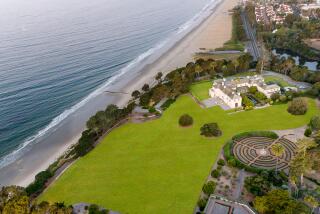Remains of the Decorator : BIOGRAPHY : NANCY LANCASTER: Her Life, Her World, Her Art,<i> By Robert Becker (Alfred A. Knopf: $40; 426 pp.)</i>
- Share via
Those who know their curtains from their drapes and their pelmets from their ruches know Nancy Lancaster.
Born and schooled in Virginia, “finished” among Europe’s aristocracy, Nancy Perkins Field Tree Lancaster was an inventor of ideas for the home. Her famous yellow room, the 1950s library of her Avery Row flat in London that was painted in a tone she described as “buttah yellah,” became a legend in interior design.
In her lifetime, from 1897 to 1994, Lancaster converted American and British houses, great and small, into the prototypes of a look that would be embraced by an entire school of decorators and, ultimately, mass-marketed by Ralph Lauren.
Blending the pre-World War II sensibilities of England’s lauded elite with the comfortable country accents she recalled from childhood summers in Virginia, she became the queen of “English country style.” Her rooms were elegant but cozy, full of flowers and chintz and something tattered and old. Lancaster liked buildings, objects and fabrics marked by the “stamp of history.” But while contriving a memorable home and garden aesthetic, Lancaster also invented herself.
Orphaned and plump, she was the not-particularly-attractive niece of the Langhorne sisters of Virginia, whose striking beauty and energy were immortalized in the Gibson Girl drawings. Her aunts included Lady Nancy Astor, first female member of the House of Commons, and Irene Gibson, wife of artist Charles Dana Gibson.
Lancaster described herself as having the “nose of an elephant” and resembling “old Mr. Ford.” But she made up for what she lacked with talent, the fortunes of her wealthy husbands and a collection of jaunty hats cocked to slightly shadow her face.
Robert Becker’s “Nancy Lancaster--Her Life, Her World, Her Art,” is a conspicuously detailed paean to Lancaster, 400-plus pages benefited by transcribed interviews with her but leadened by the author’s studiousness and obvious adoration of his subject.
For those intent on learning pre-Martha Stewart house tricks there are literally thousands. Of course, there are “houses,” such as Hasely Court, where renovations included, “five empty reception rooms, 11 neglected bedrooms, draughty hallways and uninhabitable staff quarters” not to mention the installation of eight bathrooms.
This is the “Remains of the Day” world where newspapers are ironed for breakfast guests.
More interesting than the view we are given of houses-in-the-making are the glimpses of Lancaster-in-the-making. Driven to overcome a succession of blows, she etched her life against a background of politics, war and a changing world.
Her personal background was largely abysmal.
Nancy Perkins’ parents fought ferociously and finally separated, an unusual move in Richmond, Va., in 1912. Two years later, her father died of dropsy and her mother of a stroke on the way to his funeral.
Her first handsome husband, Henry Field, son of Chicago’s Marshall Field, ate before appendix surgery, became infected as a result and died leaving Nancy, at 19, a widow after five months.
By the time she married Ronald Tree and settled in English society, she was a steely horsewoman and hostess using her homes to keep herself at the center of attention. At Ditchley Park, their 350-acre estate in North Oxfordshire, she created one the most sought-after salons of the 1930s in America or England. Edward R. Murrow, Noel Coward, Anthony Eden, Averill Harriman, William Paley and most of England’s brightest lights showed off at Ditchley.
Eden, Harold MacMillan, Duff Cooper and, later, Winston Churchill, feasted at Ditchley’s magnificent table. After war broke out, Prime Minister Churchill asked the Trees to allow him to hide there on weekends, “when the moon is high.” He feared that German reconnaissance planes had staked out his retreat at Chequers.
“I got the house ready,” Lancaster recalled, “and on Friday as I was looking out a front window I was simply amazed to find coming through the avenue of trees an armored car with Winston Churchill sitting outside in a zoot suit with a huge cigar in his mouth.”
Churchill stayed at Ditchley for 13 weekends between 1940 and 1942 while decoys of the prime minister’s ample body were placed at other estates.
Typically, she rose from the ashes by remarrying (her longtime friend and lover Col. Claude “Jubie” Lancaster) and starting on another home, Hasely Court.
But in her life, she had no one to blame and no one to thank more than herself. She ended her days in a small cottage with a garden. Thrilled, probably, by the loving attention of a young Becker on his way to writing such a glowing biography.
Becker did his work thoroughly but leaves you wondering where Lancaster’s fantasy ends and her truth begins. And finally, this: Who would choose to live in the house of Lancaster?
More to Read
Sign up for our Book Club newsletter
Get the latest news, events and more from the Los Angeles Times Book Club, and help us get L.A. reading and talking.
You may occasionally receive promotional content from the Los Angeles Times.








